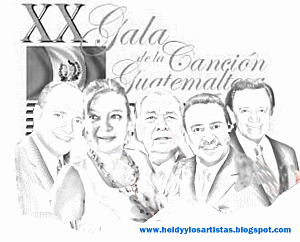Today on "Friendly face of our guests", I share with you the interview with an artist who with his love of the Marimba has led the sound of our musical instrument to countries like England, Russia and France. Believe it or not, but in his youth he wore bell bottompants and had long hair. Our guest is Lester Godínez, who was born in Taxisco in a family of musicians; in 1970 has his first public presentation which would mark a musical career of hits. Let’s receive Lester Godinez with loud applause in this space, where you can say what you want and what other media cannot.
Welcome my dear friend to this space.Thank you for accepting this interview, where you will tell us many things we still don't know about you.
To begin our interview I'd like to know how your childhood was in Taxisco, and the influence that your maternal grandfather had on you.
Although I was born in Taxisco, my first years passed in the West of the country, because my father was a master of roads.This possibly also stressed my attachment to the cultural values of the West, including the marimba and the folkloric manifestations. Therefore, we lived in Catarina, San Marcos and San Pedro, Quetzaltenango, Totonicapán, Santa Cruz del Quiché and Sololá, however, almost all weekends we got back to Taxisco.
My grandfather, Vidal Orantes Villegas, although I lived very little with him, was decisive in my inclination to music. Along with his brothers, integrated the musical group“Los Hermanos Orantes”, with Francisco (tio Pancho), and Anselmo.
¿Your father always supported you; do you remember at what age he gave you your first marimba? I was about 10 years old. In fact he never knew how far such gift would go, because with my brothers we saw it initially as a toy. Little by little I was unlocking its secrets.
¿What melody was the first that you played and why you selected it? El Tiempo Todo lo Borra of Domingo Bethancourt. Actually, my Dad gave us two marimbitas. The first was simple and didn’t play that well (white keys of the piano, were missing the flats). A year later he gave us a double marimbita, with which I felt good to play all the parts. One of my early frustrations with the first was that melody, for when we received the double keyboard, was the first melody that I played.
¿In your teens how were you?What was fashionable at the time? I was up to date in my time. I listened to the radio 9-80, in which was scheduled youth music in English with the groups of the time. At that time I listened to Billy Goldsboro, Boby Vinton, Elvis Presley, etc. Very soon, it was a group with fresh music that we loved it all,The Beatles. Then, The Animals, Rolling Stones, etc. At the same time, I listened to the Radio Panamericana and I "discovered" Bert Kaempfert, Ray Conniff, Glenn Miller, etc. The most important thing is that radio Progreso I listenedto a program of sones in marimba at 3 in the afternoon, and I started to play together with the teachers, especially Bethancourt and Hurtado. The sones have always fascinated me.
¿Tell us how you dressed yourself, did you usebell bottom pants, long hair, going to nightclubs or were you very dedicated to your study with the marimba? Indeed, I used bell bottom pants and a bit of long hair, but I didn’t go to parties, indeed, I was absorbed by my studies and the marimba.
¿What is the meaning of colonia Utatlán for you? There I developed my youth, my friends, etc., with whom I shared my music and my early inclinations for the marimba. Also practiced sports, especially soccer and amateur bicycling.
¿What other instruments besides the marimbado you play? I studied oboe and percussion at the Conservatory, and began my training as a conductor of orchestra, as I could, because there was no specific course for this purpose.
¿You are the creator of the concept of marimba concerts in the country.How does this idea startand what year are we talking about? In 1970 I observed that the marimba was in decline and that the youth was "gone" with the rock giving the back to our marimba. One of the causes was the moral fall because it was being relegated to the corner of the Ballroom, which no one cared. I thought it was time to dignify it, raising it to the seat that deserves as a concert instrument, by means of the dignity of the marimba and the marimbista. My proposal arises on May 10, 1970, when I was studying in the vocational technical Institute, where I had formed a student group. The director asked that if we can "entertain" the evening of anniversary of the Institute, to which I objected and said that we were happy to cooperate, but in the program. And so it was. The concept of marimba, as an alternative to the entertainment is born.
¿Do you remember what year you presented at the professional level and what was the activity? It was in the year 1973, invited by the Master Fernando Morales Matus to play in Herencia Maya Quiche, in the then called Teatrode la 12, 12 Street between 3rd and 4th avenues. It no longer exists.
¿You have several loves: your wife, your children and the marimba, how do you do to divide your time between your loved ones and the performance? In fact my wife (who I met by the marimba, as she was preparing a tribute concert for the teachers Bethancourt Díaz, of the Marimba Princesade Xela, Mariano, Ruben and Fabián. (My wife was the granddaughter of the Master Rubén Bethancourt Díaz). She has taken charge of the training and care of the children, notan easy task, but it allowed me to better develop my musical career (marimba, jazz, recording of jingles, studies, etc.).
.jpg) ¿Have any of your sons followed your career? At the appropriate time it was not possible, because they havetoo much homework at school and I did not want to sacrifice them. However, the three boys played marimba and they integrated to the first child concert Marimba. They gave recitals at the children's Museum, national theatre, closures of Angelica Rosa, etc. Now, the first is an engineer in systems, another is finishing the master degree in e-business and make applications for Apple, and the third is ending business economics. The girl, the oldest, graduated BA in CC of communication, majoring in Radio and TV production. She currently works at Publinews.
¿Have any of your sons followed your career? At the appropriate time it was not possible, because they havetoo much homework at school and I did not want to sacrifice them. However, the three boys played marimba and they integrated to the first child concert Marimba. They gave recitals at the children's Museum, national theatre, closures of Angelica Rosa, etc. Now, the first is an engineer in systems, another is finishing the master degree in e-business and make applications for Apple, and the third is ending business economics. The girl, the oldest, graduated BA in CC of communication, majoring in Radio and TV production. She currently works at Publinews.
¿How many compositions do you have under your belt? Approximately 30 pieces, mostly sones. I created the Son de Proyección Folklórica, cas El Sembrador, La Pedrera, Nim K’ij, etc.
¿Which countries have youvisited in the last 15 years? Germany, Austria, Spain, France, England, Italy, Portugal, Norway, Sweden, Russia and Serbia, as well as Brazil, Chile, Colombia, Cuba, Ecuador, United States, Canada, Mexico, Puerto Rico, Venezuela, Belize, Central America, Israel, Japan and Taiwan.
¿How were you received abroad and what the warmer country where they have stood up is and say bravo! One more, one more? In fact, all countries succumb to the charms of the marimba. I would say that acceptance is similar in all countries, because they admire that an instrument with the appearance of "furniture" or "counter" may arise to symphonies and contemporary works. In Germany, they admired that we didn't have a director in front of us and we were not reading music at a lectern.
¿Do you consider yourself a defender of the marimba? Of course, a defender and a dignificador.
 ¿What do you think of the teachers Fidel Funes and César Gálvez (+)? Fidel Funes played with me in the Marimba de Concierto de Bellas Artes, and Checha, as a friend and partner and colleague. Both are extraordinary, each with its own features. I love the Porro of Jaime and Flores andMamá de Checha. Fidel has done a great job of broadcasting the marimba Orchestra, which is as Guatemalan as the chuchitos.
¿What do you think of the teachers Fidel Funes and César Gálvez (+)? Fidel Funes played with me in the Marimba de Concierto de Bellas Artes, and Checha, as a friend and partner and colleague. Both are extraordinary, each with its own features. I love the Porro of Jaime and Flores andMamá de Checha. Fidel has done a great job of broadcasting the marimba Orchestra, which is as Guatemalan as the chuchitos.
¿With which of the national teachers would you wish to perform a concert? With all of them. I get along well with everyone.
¿What projects do you have for the rest of the year? I have some commitments of concerts I intend to perform, both with marimba and with my jazz band.
¿By the way and before the end of this interview, we can see you have two facets in your artistic life: marimba music and jazz, speaking of jazz, when did you start your Orchestra and with which elements you complemented it? The first group, The Jazz Train Express, founded in 1980, in the line of fusion jazz and jazz rock. It was composed of musicians as Malin Villagran, KC Porter, Luis Estrada, Cesar Sazo, Félix Torres.
In April 1997, I had the opportunity to establish the Jazz Train Big Band for a Central American Congress of dentistry at the National Theatre, as a long-cherished dream. Musicians of great stature, such as German Giordano, Javier García, Armando Trujillo, Arturo Xicay, Ramiro Vivar, Moisés Vidal have paraded. In 2004 it expanded to the mode of Orchestra and chorus, with a choir of 12 Professional voices, to play the music of Ray Conniff, modality that proved to be a resounding success.
¿Have any international artists participated in your band? The American singer Wayne Hooper, the pianist Rich Ridenour, the singer Kathy Wagner.
¿Do you interpret only international music or do you do Guatemalan music arrangements? We have made arrangements of Guatemalan music, as el Ferrocarril de Los Altos, Luna de Xelajú, Chichicastenango, etc.
¿What do you think about Mr. Bob Porter who turned out more Guatemalan than tamales and to whom we send our affectionate greetings wishing his speedy recovery? Bob has been a great support in the realization of the musical arrangements, and who now is missed a lot, because he is in recovery in the United States. He is a tremendous composer, we hope he recovers.
¿Tell me, can you adapt a marimba to a jazz band? Of course, the marimba can be adapted to the jazz band. Already I have done in some solos of Latin jazz, especially. The opposite, the Big Band adapted to the marimba and thus to marimba Orchestra in the Decade of the 1940s.
I appreciate your time and the opportunity to know more, not only the friend, but that the man and the artist who has achieved so much, fighting for the dignification of the marimba.
Interview by Heidy Sandoval Ruiz
Translation René Corado
You can read the interviews on these links:


























